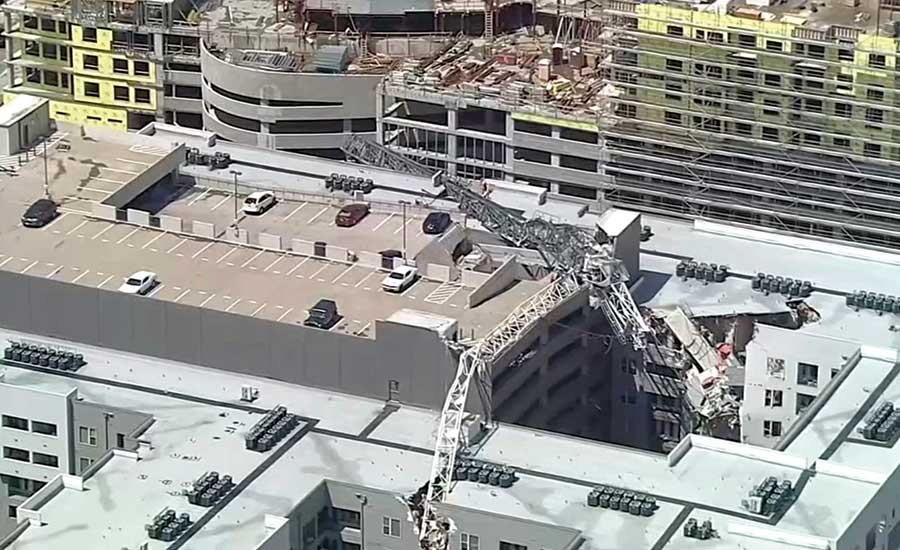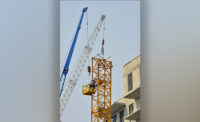A spate of fatal crane accidents in Texas has cast a spotlight onto the Lone Star State’s relatively hands-off approach to overseeing the safety of the big machines.
OSHA is still investigating a crane collapse in Dallas on June 9 that killed one person and injured five others when a tower crane crashed into an apartment building. Winds of up to 71 mph were reported at the time, well within the 95-mph limit that the manufacturer of the Terex Peneir SK415 lists as the maximum wind speed the crane can withstand.
There were 50 crane-related fatal accidents in Texas from 2011 to 2017, according to the Bureau of Labor Statistics, with Florida and New York the only states remotely close to that number, at 16 each.
A lack of training and experience for crane operators is a major cause of accidents, says Tom Barth, a crane operator and accident investigator who has looked at dozens of cases over the years.
In Barth’s estimation, almost all of those accidents were not the result of faulty equipment, but rather of human error, often by inexperienced crane operators, he says.
Barth says training standards have declined over the years, with many operators learning on the job. “It’s human error, human error,” Barth says. “I have never seen an accident caused by the crane itself.”
In the case of the fatal accident in Dallas, Barth questions whether the operator unlocked the parking brakes after shutting the machine down for the day.
Cranes have withstood high winds in the past, but manufacturers recommend that the turntable’s brakes be unlocked so the crane can spin freely, allowing the crane to “weathervane” and reduce the amount of wind-surface area.
Graham Brent, former CEO of the National Commission for the Certification of Crane Operators, says weathervaning is a standard industry practice. “It is generally understood the weathervaning is necessary on cranes in order to avoid a situation where the crane is resisting the wind,” Brent says. He also disputes the idea that crane collapses are predominately due to human error, with high winds a major threat to cranes.
Barth says he has watched videos of the Dallas crane collapse online and did not see the crane weathervaning before it collapsed. Another crane nearby went through the same high winds, but weathervaned and did not collapse.
A couple who arrived at the apartment building to visit a friend just as the crane was about to collapse told CBS 11 in Dallas that the crane appeared to start to spin right before it toppled over.
“The crane started to sway and it kind of looked like it was spinning like a normal crane would do in windy situation until it took it one tip. … It happened in seconds and the crane completely collapsed,” one of those eyewitnesses said.
An OSHA spokesperson declined to comment to ENR, citing an ongoing investigation. California-based Bigge Crane and Rigging Co. leased the crane to the apartment development company, Greystar. Bigge, in a statement, said it believes “extreme local wind conditions caused this crane accident” and that the operator followed correct procedures when exiting the tower crane at the end of the day.
Lack of State and Local Regulations
The fatal crane collapse in Dallas has also drawn attention to whether there is sufficient oversight and regulation of crane safety on the state and local level in Texas.
State Sen. Royce West (D-Dallas), in whose district the crane collapse happened, has said that Texas should consider new safety regulations. West could not be reached for comment. The Texas Legislature, which only convenes every other year, is not set to meet again until 2021.
There is no state licensing requirement to be a crane operator in Texas, says Tela Goodwin Mange, a spokesperson for the Texas Dept. of Licensing and Regulation. She is not aware of any licensing by Texas cities on the local level.
Still, Texas is in the majority when it come to this lack of oversight, with just 16 states and seven cities across the country currently licensing crane operators.
On the national level, there has been some effort to boost training of crane operators and conduct more on-the-spot inspections as well. Starting earlier this year, OSHA began requiring crane operators across the country to become certified on their equipment before going out into the field (ENR 12/24/18 p. 12).
Citing a concerning number of fatal crane accidents in Texas, as well Arkansas, Louisiana, Oklahoma and parts of New Mexico, OSHA launched an initiative last fall to ramp up crane inspections. Barth questions whether the agency has the resources and expertise to keep on top of routine inspections, but greatly values their post-accident analysis. “I will say when there is an accident, I always wait for the OSHA report,” Barth said. “They get their best people out there.”





